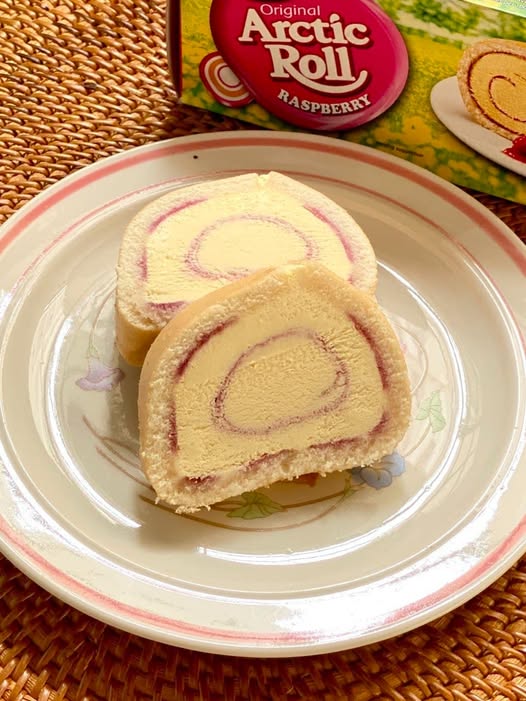The Arctic Roll is more than just a frozen treat—it’s a slice of culinary history that evokes fond memories of family gatherings and simpler times. Invented in the 1950s by Dr. Ernest Velden, a Czech immigrant who settled in Eastbourne, England, this dessert quickly became a staple in British households.
🧁 What Is an Arctic Roll?
An Arctic Roll consists of vanilla ice cream encased in a thin layer of sponge cake, with a swirl of raspberry jam nestled between the two. Its cylindrical shape and vibrant cross-section make it visually appealing and instantly recognizable. Traditionally served in slices, it was often shared among families—sometimes feeding up to six people—making it a budget-friendly indulgence.
🕰️ Rise, Fall, and Revival
- 1958: Velden began mass-producing Arctic Rolls, and by the 1980s, Birds Eye was selling over 25 miles of the dessert each month.
- 1990s: Popularity waned, and production ceased.
- 2008: Amid economic downturns, the Arctic Roll made a comeback as consumers sought affordable comfort foods. Birds Eye reported sales of £3.5 million within months of its re-release.
🧠 Why It Resonates
The Arctic Roll is cherished not just for its taste but for its nostalgic value. It represents a time when desserts were simple, shared, and homemade. Its resurgence in the 2000s was driven by emotional connections as much as economic ones. While some critics have dismissed it as outdated, others embrace it as a comfort food icon.
🍓 Variations and Modern Appeal
Though the classic version features vanilla ice cream and raspberry jam, modern iterations include:
- Chocolate ice cream rolls
- Fruit jam alternatives like strawberry or apricot
- Gourmet versions with artisanal ingredients
🥄 Serving Suggestions
To elevate the experience:
- Serve slightly thawed for a softer sponge texture
- Pair with fresh berries or whipped cream
- Add a drizzle of chocolate or dusting of icing sugar for flair
The Arctic Roll is more than just a frozen treat—it’s a slice of culinary history that evokes fond memories of family gatherings and simpler times. Invented in the 1950s by Dr. Ernest Velden, a Czech immigrant who settled in Eastbourne, England, this dessert quickly became a staple in British households.
🧁 What Is an Arctic Roll?
An Arctic Roll consists of vanilla ice cream encased in a thin layer of sponge cake, with a swirl of raspberry jam nestled between the two. Its cylindrical shape and vibrant cross-section make it visually appealing and instantly recognizable. Traditionally served in slices, it was often shared among families—sometimes feeding up to six people—making it a budget-friendly indulgence.
🕰️ Rise, Fall, and Revival
- 1958: Velden began mass-producing Arctic Rolls, and by the 1980s, Birds Eye was selling over 25 miles of the dessert each month.
- 1990s: Popularity waned, and production ceased.
- 2008: Amid economic downturns, the Arctic Roll made a comeback as consumers sought affordable comfort foods. Birds Eye reported sales of £3.5 million within months of its re-release.
🧠 Why It Resonates
The Arctic Roll is cherished not just for its taste but for its nostalgic value. It represents a time when desserts were simple, shared, and homemade. Its resurgence in the 2000s was driven by emotional connections as much as economic ones. While some critics have dismissed it as outdated, others embrace it as a comfort food icon.
🍓 Variations and Modern Appeal
Though the classic version features vanilla ice cream and raspberry jam, modern iterations include:
- Chocolate ice cream rolls
- Fruit jam alternatives like strawberry or apricot
- Gourmet versions with artisanal ingredients
🥄 Serving Suggestions
To elevate the experience:
- Serve slightly thawed for a softer sponge texture
- Pair with fresh berries or whipped cream
- Add a drizzle of chocolate or dusting of icing sugar for flair

